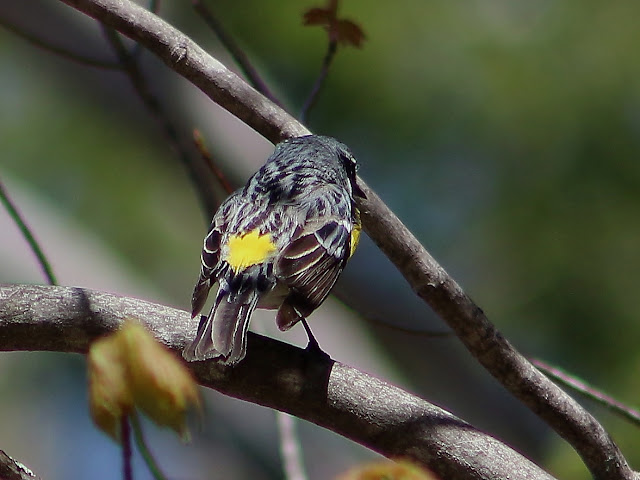A few sunny days in late April really get things moving - the sun is as strong now as it is at the end of July. In warm, damp, sunny spots ferns are shooting out of the ground, their fiddle heads mimicking the top of a violin.
They are so small you may have to look carefully to find them. Trailing Arbutus, along with Partridge Berry are some of our forests' more common ground covers, helping to maintain moisture in the soil as well as providing food and cover for the smallest of animals. I saw my first bee of the year buzzing among the Trailing Arbutus - it was a bumble bee, the primary pollinator of this plant. These large bees with a hairy coat can stand colder temperatures, and are the first bees to emerge after winter. If you find Trailing Arbutus flowers, pinch one of their flowers and smell the strong, sweet perfume that attracts the bees.
 |
| Yellow-rumped Warbler. |
They flit erratically among the bare branches picking off insects and caterpillars.
Yellow-rumpeds spend the winter farther north than most warblers so they arrive early, allowing us to see them rather than just hear them since the bare tree branches give them no cover.
 |
| Caught this one in action. |
Yellow-rumpeds spend the winter farther north than most warblers so they arrive early, allowing us to see them rather than just hear them since the bare tree branches give them no cover.
 |
| How they got their name. |
Bare tree branches let me watch a Tufted Titmouse forage around in a young successional forest picking off insects and spiders.
We'll lose those bare branches in just a few more days so the birds will be well hidden up in the treetops. The trees are now starting to put out leaves; the view down on treetops from Crockett's Ledge shows tinges of pale yellow-green aspen and dark red maple buds.
Other new arrivals this week include Oven Bird, Common Yellowthroat, and Veery. But my bird of the week was this Broad-winged Hawk which spent time hanging out amidst the warblers.
 |
| Broad-winged Hawk |
I was surprised that while it was here the warblers will still flying around in the trees. The hawk wasn't trying to be secretive because it twice flew from one tree to another.
So the warblers were certainly aware of its presence. Are warblers smart enough to tell a broad-winged hawk apart from the smaller Merlin and Kestrel, and know that broad-wings mostly go after small animals on the ground? They should keep in mind that these hawks do occasionally take a bird on the wing.
 |
| It also walked up and down a branch, showing off its talons. |
So the warblers were certainly aware of its presence. Are warblers smart enough to tell a broad-winged hawk apart from the smaller Merlin and Kestrel, and know that broad-wings mostly go after small animals on the ground? They should keep in mind that these hawks do occasionally take a bird on the wing.
One quiet morning as I was listening to the birds' sunrise serenade beside the lake, I jumped a foot in the air when a beaver gave a loud slap just a few yards away from me. I hadn't seen it coming and it really is startling when you're not expecting it. I watched it swim back and forth, and it presented me with a couple more tail slaps.
There was another noisy event on the lake this week: The loons are back to fighting over either territory or mates. Two days after I took a nice trip around the lake and was pleased at seeing two pairs of loons peacefully enjoying their separate territories, I witnessed the most intense loon battle I've ever seen. I heard a ruckus and looked out and saw two loons in a wing-rowing chase winding back and forth across the lake at breakneck speed - they looked like waterskiers carving up the cove. When they reached the end of the cove they went back and forth multiple times, chasing, diving to make sharp stops and turns, barely losing a beat. I had watched for a long time not wanting to look away, but eventually I got my camera.
They went out of my sight, but then came back and I took more video until they went far down the lake. I checked my watch only after they'd been at it for at least a few minutes - I have no idea how long it was going on before they caught my attention, but it was ten minutes that I watched before they went back out of sight, still in active combat.
I'm amazed at their endurance; that video was only two and a quarter minutes of a fight that went on well over ten minutes and they never once stopped going full tilt. I can only assume one of the contestants is the north territory male. It seems it would be one doing the chasing to drive another away, but it could be the other way around. It could also be two females fighting over who gets to pair with the male. Hopefully someone will give up rather than fight to the death. But what will happen if the weaker bird gets so exhausted it can't escape? I was happy to see a pair together fishing peacefully in the northern territory the next morning.
Some of the trees and shrubs I like to watch progress in spring are Service Berry, Black Cherry, and Hobblebush Viburnmum, all of which are pushing out small leaves now. The viburnum is the furthest along, already forming flower buds.
 |
| Hobblebush Viburnum early buds. |
All three of these shrubs/trees might have blossoms by next week - stay tuned!




So peaceful and beautiful is the video, and are the photos, Scott!
ReplyDelete